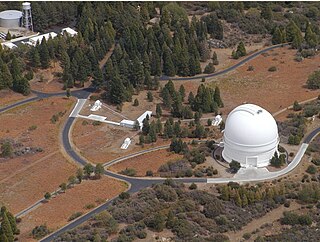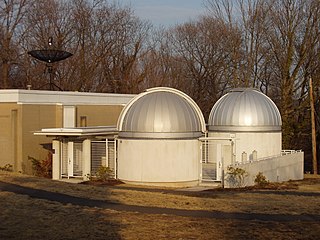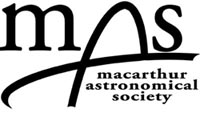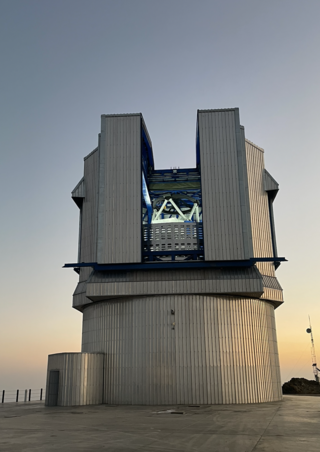
Amateur astronomy is a hobby where participants enjoy observing or imaging celestial objects in the sky using the unaided eye, binoculars, or telescopes. Even though scientific research may not be their primary goal, some amateur astronomers make contributions in doing citizen science, such as by monitoring variable stars, double stars, sunspots, or occultations of stars by the Moon or asteroids, or by discovering transient astronomical events, such as comets, galactic novae or supernovae in other galaxies.

An observatory is a location used for observing terrestrial, marine, or celestial events. Astronomy, climatology/meteorology, geophysics, oceanography and volcanology are examples of disciplines for which observatories have been constructed.

Palomar Observatory is an astronomical research observatory in the Palomar Mountains of San Diego County, California, United States. It is owned and operated by the California Institute of Technology (Caltech). Research time at the observatory is granted to Caltech and its research partners, which include the Jet Propulsion Laboratory (JPL), Yale University, and the National Astronomical Observatories of China.

The Cerro Tololo Inter-American Observatory (CTIO) is an astronomical observatory located on the summit of Mt. Cerro Tololo in the Coquimbo Region of northern Chile, with additional facilities located on Mt. Cerro Pachón about 10 kilometres (6.2 mi) to the southeast. It is approximately 80 kilometres (50 mi) east of La Serena, where support facilities are located. The principal telescopes at CTIO are the 4 m Víctor M. Blanco Telescope, named after Puerto Rican astronomer Víctor Manuel Blanco, and the 4.1 m Southern Astrophysical Research Telescope, which is situated on Cerro Pachón. Other telescopes on Cerro Tololo include the 1.5 m, 1.3 m, 1.0 m, and 0.9 m telescopes operated by the SMARTS consortium. CTIO also hosts other research projects, such as PROMPT, WHAM, and LCOGTN, providing a platform for access to the southern hemisphere for U.S. and worldwide scientific research.

Stardome Observatory & Planetarium is a public astronomical observatory and planetarium situated in Maungakiekie/One Tree Hill Domain in Auckland, New Zealand.

Siding Spring Observatory near Coonabarabran, New South Wales, Australia, part of the Research School of Astronomy & Astrophysics (RSAA) at the Australian National University (ANU), incorporates the Anglo-Australian Telescope along with a collection of other telescopes owned by the Australian National University, the University of New South Wales, and other institutions. The observatory is situated 1,165 metres (3,822 ft) above sea level in the Warrumbungle National Park on Mount Woorat, also known as Siding Spring Mountain. Siding Spring Observatory is owned by the Australian National University (ANU) and is part of the Mount Stromlo and Siding Spring Observatories research school.

The Kopernik Observatory & Science Center (KOSC), is a public observatory in Vestal, New York opened to the public on June 16, 1974, by the Kopernik Society of Broome County to commemorate the 500th anniversary of the birth of the astronomer Nicolaus Copernicus in 1973. Its mission is to offer hands-on investigations and outreach programs for educating all ages about astronomy and science using advanced optical telescopes, computers and other tools. It is the first science laboratory facility in New York State designed for K-12 teachers, students and their families, and has been one of the best-sited and best equipped public observatories in the Northeast United States for nearly the last 40 years.

The Institute of Astronomy (IoA) is the largest of the three astronomy departments in the University of Cambridge, and one of the largest astronomy sites in the United Kingdom. Around 180 academics, postdocs, visitors and assistant staff work at the department.

The Indian Astronomical Observatory (IAO) is a high-altitude astronomy station located in Hanle, India and operated by the Indian Institute of Astrophysics. Situated in the Western Himalayas at an elevation of 4,500 meters (14,764 ft), the IAO is one of the world's highest located sites for optical, infrared and gamma-ray telescopes. It is currently the tenth-highest optical telescope in the world.

The Astronomical Observatory of Belogradchik or Belogradchik Observatory is an astronomical observatory owned and operated by the Institute of Astronomy of the Bulgarian Academy of Sciences. It is located near the town of Belogradchik in northwestern Bulgaria, at the foot of the Western Balkan Mountains. The other observatory operated by the same institute is the Rozhen Observatory.
Leuschner Observatory, originally called the Students' Observatory, is an observatory jointly operated by the University of California, Berkeley and San Francisco State University. The observatory was built in 1886 on the Berkeley campus. For many years, it was directed by Armin Otto Leuschner, for whom the observatory was renamed in 1951. In 1965, it was relocated to its present home in Lafayette, California, approximately 10 miles (16 km) east of the Berkeley campus. In 2012, the physics and astronomy department of San Francisco State University became a partner.

Mount Laguna Observatory (MLO) is an astronomical observatory owned and operated by San Diego State University (SDSU). MLO is located approximately 75 kilometers (47 mi) east of downtown San Diego, California, on the eastern edge of Cleveland National Forest, in the Laguna Mountains on the SDSU Astronomy Campus near the hamlet of Mount Laguna.

The Yale University Observatory, also known as the Leitner Family Observatory and Planetarium, is an astronomical observatory owned and operated by Yale University, and maintained for student use. It is located in Farnham Memorial Gardens near the corner of Edwards and Prospect Streets, New Haven, Connecticut.

The Norman Lockyer Observatory, the Lockyer Technology Centre, and the Planetarium, is a public access optical observatory 1 mile (1.6 km) east of Sidmouth, East Devon in South West England. It houses a number of historical optical telescopes, including the Lockyer Telescope, and is operated by Norman Lockyer Observatory Society (NLOS).

Table Mountain Observatory (TMO) is an astronomical observation facility operated by NASA's Jet Propulsion Laboratory. It is located in Big Pines, California, in the Angeles National Forest near Wrightwood, north-northeast of Los Angeles, California.

Puckett Observatory is a private astronomical observatory located in the state of Georgia. It is owned and operated by Tim Puckett. Its primary observation goals are the study of comets and the discovery of supernovae. To facilitate the latter goal it sponsors the Puckett Observatory World Supernova Search whose astronomers have discovered 369 supernovae.

The National Astronomical Research Institute of Thailand, or NARIT, is a research institute under the Ministry of Higher Education, Science, Research and Innovation. NARIT's headquarters are in Chiang Mai, Thailand. The main missions of the institute are to carry out, support, and promote the development of astronomy and astrophysics in Thailand through research, public outreach, and educational activities.

Macarthur Astronomical Society is an organisation of amateur astronomers, based in the Macarthur Region of outer South Western Sydney, New South Wales, Australia.

Iranian National Observatory (INO) is an Iranian astronomical observatory inaugurated in 2021. It has reported the capture of its first light on 15 October 2022 upon the commissioning of INO340, a home-grown optical telescope with a primary mirror of 3.4 m, making it by far the country's largest astronomical research facility.


















